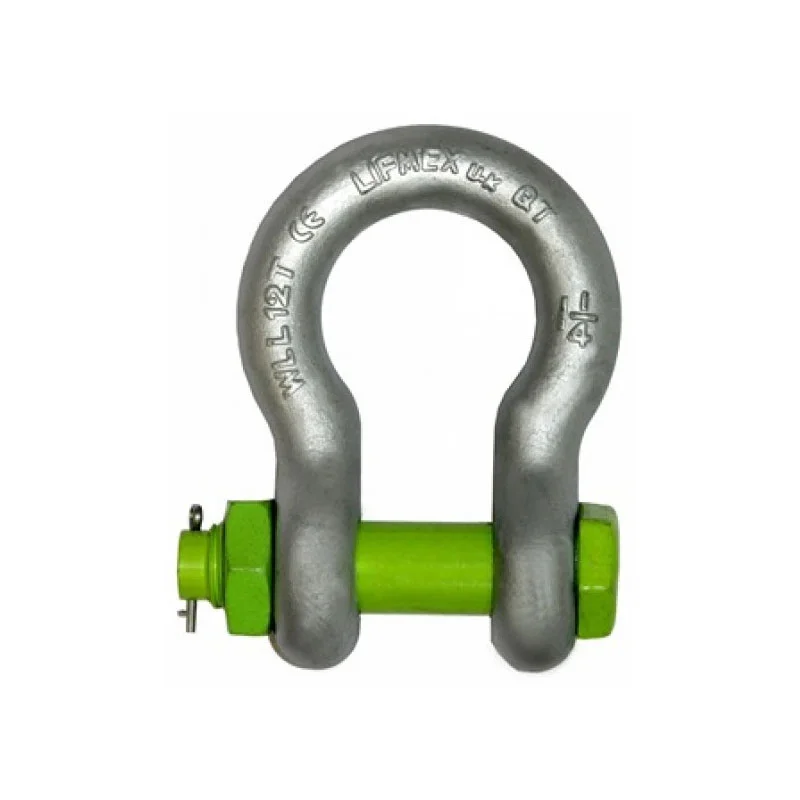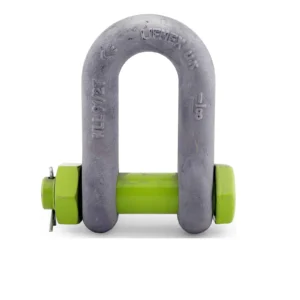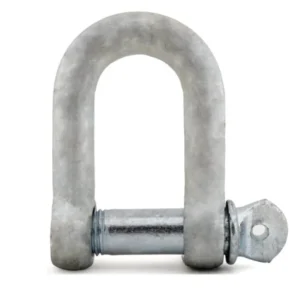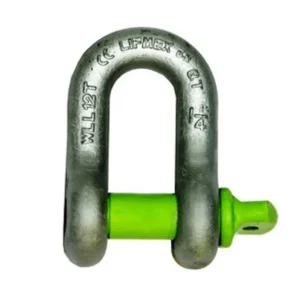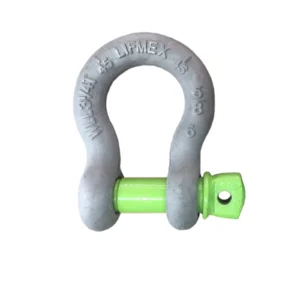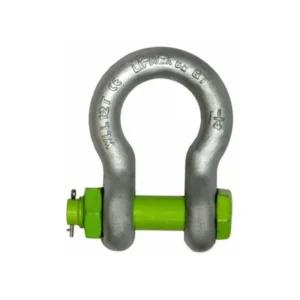Q1. What is a D Shackle?
A D shackle, or chain shackle, is a crucial rigging component with a ‘D’ shape design and a threaded pin closure. Various industries use this versatile tool for lifting, towing, and securing loads due to its robust construction. Typically crafted from durable materials such as stainless steel or galvanized steel, it provides exceptional strength and reliability in demanding environments. Its straightforward yet effective design allows for easy attachment and detachment, making it indispensable in rigging operations where safety and efficiency are paramount.
Q2. How to Calculate D Shackle Capacity?
Determining D shackle capacity involves considering factors like Working Load Limit (WLL), load angle, and D/d ratio. The formula Capacity = WLL × D/d Ratio helps ensure safe lifting operations by matching the shackle’s strength to the load requirements.
Q3. How to Measure D Shackle Size?
We determine the size of a D shackle by measuring the pin diameter, bow width, and overall length. Accurate measurements are crucial for selecting compatible equipment and ensuring safe usage in various applications.
Q4. How to Use the D Shackle?
To use a D shackle safely, follow these steps
1. Proper Alignment: Ensure that the load and attachment points are correctly aligned with the shackle. Misalignment can lead to uneven stress distribution and potential failure.
2. Secure Pin Closure: Insert the pin through the shackle’s holes and ensure it’s properly seated. For screw pin shackles, hand-tighten the pin and then use a wrench to fully secure it. This prevents accidental disengagement during operation.
3. Distribute Load Evenly: Place the load evenly on both sides of the shackle to prevent uneven stress. Avoid side-loading, which can weaken the shackle or cause it to fail unexpectedly.
4. Follow Manufacturer Guidelines: Consult the manufacturer’s instructions for the specific type and size of D shackle you’re using. They may provide additional usage recommendations and safety precautions.
5. Regular Inspections: Before each use, inspect the D shackle for signs of wear, deformation, or damage. Inspect the shackle for cracks, corrosion, or elongation of the pin holes, as these factors can compromise its strength. Replace the shackle immediately if you find any issues.
6. Usage Limits: Adhere to the shackle’s Working Load Limit (WLL) and other rated capacities specified by the manufacturer. Exceeding these limits can lead to catastrophic failure and pose significant safety risks.
7. **Environmental Considerations**: Take into account environmental factors such as temperature, moisture, and chemical exposure, which can affect the shackle’s performance. Choose the appropriate material and finish (e.g., stainless steel for corrosion resistance) for the specific operating conditions.
8. Training and Certification: Ensure that personnel involved in rigging operations are adequately trained and certified in safe rigging practices. Proper training reduces the risk of accidents and enhances overall safety.
Q5. What Size D Shackle for Caravan?
Selecting the appropriate size D shackle for a caravan is crucial for safe towing operations. Here’s how to determine the right size:
1. Consider Caravan Weight: The size of the D shackle should be suitable for the weight of your caravan. Determine the laden weight of the caravan, including any cargo or additional equipment it may carry during towing.
2. Towing Setup: Assess the towing setup, including the type of tow hitch and coupling mechanism used. Different towing setups may require specific sizes or types of D shackles for proper attachment and compatibility.
3. Consult Load Charts: Refer to load charts or tables provided by manufacturers or industry standards organizations. Typically, these resources offer guidance on selecting the appropriate size of D shackle based on the load or weight being lifted or towed.
4. Seek Professional Advice: When in doubt, consult with industry professionals, such as rigging experts or caravan manufacturers. They can provide personalized recommendations based on the specific characteristics of your caravan and towing setup.
5. Consider Safety Factors: Err on the side of caution and choose a D shackle with a higher working load limit (WLL) than the anticipated load. This provides an extra margin of safety and helps prevent overloading of the shackle.
6. Inspect Regularly: Regardless of the size chosen, it’s essential to inspect the D shackle regularly for signs of wear, deformation, or damage. To ensure continued safety during towing operations, replace the shackle if you detect any issues.
Q6. Is a D Shackle for Lifting?
People commonly use D shackles for lifting because of their high strength and reliability. However, it’s essential to adhere to lifting regulations and standards to ensure safe lifting operations.
Q7. Is a D Shackle for Wire Rope?
D shackles can be used with wire ropes, provided they match the rope’s diameter and have adequate load capacity. Confirm compatibility and consult rigging experts for safe usage guidelines.
Q8. Is a D Shackle for Towing?
Yes, D shackles are suitable for towing applications, but it’s crucial to select the correct size and ensure secure attachment to prevent accidents and equipment damage.
Q9. D Shackle for Trailer?
Moreover, utilize a D shackle suitable for the trailer’s load capacity and towing requirements. Additionally, regular inspections for wear and tear are essential to ensure safe towing operations.
Q10. D Shackle with Safety Pin?
A D shackle with a safety pin is designed with an additional feature to enhance safety during lifting or towing operations. Here’s an explanation of its uses, how to use it, and maintenance considerations:
Uses
A D shackle with a safety pin is particularly useful in critical lifting or towing applications where the consequences of accidental pin release could be severe. This safety feature provides an extra layer of protection against unintentional loosening of the pin, reducing the risk of equipment damage, injuries, or accidents. It’s commonly employed in industries such as construction, maritime, rigging, and towing, where safety is paramount.
How to Use
Using a D shackle with a safety pin follows the same basic steps as using a standard D shackle:
1. Align Load:Ensure that the load and attachment points are properly aligned with the shackle. Additionally, verify that the load is evenly distributed to prevent uneven stress on the shackle.
2. Insert Pin: Insert the pin through the shackle’s holes just as you would with a standard D shackle. Likewise, make sure to securely fasten the pin to maintain the integrity of the connection.
3. Secure Safety Pin: After inserting the pin, transition smoothly to engaging the safety mechanism, typically a cotter or spring-loaded pin, to prevent it from accidentally coming loose. This extra step ensures that even if the main pin were to loosen, the safety pin acts as a backup to keep the shackle securely closed.
4. Inspect:Before each use, visually inspect the D shackle and safety pin for any signs of wear, damage, or corrosion. Furthermore, ensure that the safety pin is fully engaged and functioning correctly.
5. Regular Maintenance: Perform regular maintenance tasks, such as cleaning and lubricating the shackle and safety pin, to prevent corrosion and ensure smooth operation. Furthermore, replace any worn or damaged components promptly to maintain optimal safety and performance.
Maintenance
Proper maintenance of a D shackle with a safety pin is essential to ensure its reliability and effectiveness. Moreover, here are some maintenance tips:
1. Cleaning: Regularly clean the shackle and safety pin to remove dirt, debris, and contaminants that could affect their operation. Additionally, this helps ensure optimal performance and reliability of the D shackle.
2. Lubrication: Apply a suitable lubricant to the pin and safety mechanism to ensure smooth operation and prevent corrosion. Moreover, this helps maintain the functionality and longevity of the D shackle.
3. Inspection: Before each use, transition smoothly into conducting thorough visual inspections of the shackle and safety pin to ensure their integrity and functionality. Furthermore, check for signs of wear, deformation, or damage that could compromise their integrity.
4. Replacement:Replace any worn, damaged, or corroded components promptly to maintain the safety and functionality of the D shackle. Additionally, this ensures continued reliability and performance in rigging operations.
Q11. D Shackle with Bolt?
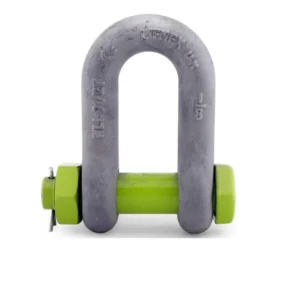 D shackles with bolts provide a secure fastening method for a wide range of applications, offering reliability and strength. Here’s an explanation of their usage and the importance of regular inspection:
D shackles with bolts provide a secure fastening method for a wide range of applications, offering reliability and strength. Here’s an explanation of their usage and the importance of regular inspection:
Usage
D shackles with bolts feature a threaded bolt or pin closure instead of the traditional screw pin. Additionally, this design offers enhanced security and stability, making them suitable for demanding applications such as lifting, towing, and rigging. The bolted connection ensures that the shackle remains securely closed, even under high loads or vibration.
These shackles are commonly used in scenarios where safety is paramount, such as lifting heavy loads or securing critical equipment. Their secure fastening method provides peace of mind to operators and helps prevent accidents or equipment failure.
Regular Inspection
Regular inspection of the bolt’s condition is essential to ensure the safe usage of D shackles with bolts. Here’s why it’s necessary:
1. Safety Assurance: Regular inspection helps ensure that the bolt remains in good condition and capable of securely holding the shackle together. Moreover, any signs of wear, damage, or corrosion can compromise the integrity of the bolted connection, increasing the risk of failure.
2. Preventive Maintenance: Inspecting the bolt regularly allows operators to identify potential issues early on and take corrective action before they escalate. Consequently, this proactive approach helps prevent accidents, injuries, or damage to equipment.
3. Compliance with Standards: Many industries have specific regulations or standards governing the use of lifting and rigging equipment. Additionally, regular inspection of D shackles with bolts helps ensure compliance with these standards and regulations, maintaining a safe working environment.
4. Prolonged Lifespan: Timely identification and replacement of worn or damaged bolts can prolong the lifespan of the D shackle and ensure continued reliability and performance. As a result, this can result in cost savings by avoiding premature replacement or repair of equipment.
During inspection, operators should carefully examine the bolt for signs of wear, deformation, corrosion, or thread damage. Any abnormalities should be addressed promptly by replacing the bolt with a new one from a reputable manufacturer.
Q12. D Shackle with Split Pin?
D shackles with split pins utilize split pins as a reliable locking mechanism to secure the pin in place. Here’s an explanation of their functionality and benefits:
Functionality
A split pin, also known as a cotter pin, is a metal fastener with two tines that are bent during installation to secure it in place. In the context of D shackles, the split pin is inserted through the pin’s hole after it is placed in the shackle’s body. The tines of the split pin are then bent to prevent the pin from sliding out, effectively locking it in place.
Benefits
- Reliable Security: Split pins provide a dependable locking mechanism that prevents the pin from coming loose, even under heavy loads or vibration. Consequently, this ensures the safety and security of the shackle’s connection, reducing the risk of accidents or equipment damage.
- Ease of Installation: Split pins are relatively easy to install and remove compared to other locking mechanisms. They do not require special tools or equipment and can be installed quickly by hand, saving time and effort during setup.
- Maintenance: Split pins allow for easy inspection and maintenance of the shackle. Operators can visually inspect the split pin’s condition during regular checks and replace it if signs of wear or damage are observed. This proactive approach helps ensure the continued reliability and safety of the shackle.
- Versatility: D shackles with split pins are versatile and can be used in a wide range of applications, including lifting, rigging, towing, and anchoring. Additionally, their simple yet effective design makes them suitable for various industries and environments.
Q13. D Shackle Sizes?
D shackles come in a range of sizes to suit diverse load capacities and applications. These sizes are typically determined by the diameter of the shackle’s pin and the width of its body. Here’s an overview of D shackle sizes and how to select the right one
- Pin Diameter: The pin diameter is a crucial factor in determining the size of a D shackle. Consequently, it affects the shackle’s strength and load-carrying capacity. Common pin diameters range from a fraction of an inch to several inches, with larger pins able to accommodate heavier loads.
- Body Width: The width of the shackle’s body also varies across different sizes. Wider bodies provide increased strength and stability, making them suitable for heavier loads. However, the body width should be compatible with the attachment points and equipment being used.
- Working Load Limit (WLL):Each size of D shackle is rated for a specific working load limit (WLL), which indicates the maximum load it can safely support. Therefore, it’s crucial to select a shackle size with a WLL that exceeds the anticipated load to ensure safety and prevent overloading.
- Consult Size Charts and Specifications: Manufacturers provide size charts and specifications detailing the dimensions and WLL of each D shackle size. Consequently, these resources help users accurately select the appropriate shackle size for their specific requirements.
- Consider Application Requirements: When choosing a D shackle size, consider factors such as the type of load, environmental conditions, and rigging setup. Different applications may necessitate different sizes of D shackles to ensure optimal performance and safety.
- Professional Guidance: In complex or high-stakes applications, it may be advisable to seek guidance from rigging professionals or engineers. Furthermore, they can offer expert advice on selecting the right size of D shackle based on the specific parameters of the job.
Q14. Types of D Shackles?
Certainly! Here’s an explanation of the common types of D shackles:
1. Screw Pin D Shackles
Screw pin D shackles feature a threaded pin that screws into the shackle’s body, providing a secure closure. They are easy to install and remove, making them suitable for applications where frequent attachment and detachment are required. However, they may be prone to accidental loosening under vibration or movement, so they are not recommended for critical or high-stakes operations.
2. Safety Bolt D Shackles
Safety bolt D shackles, also known as bolt and nut type D shackles, feature a bolt and nut mechanism for closure instead of a screw pin. This design offers enhanced security and stability, making them suitable for demanding applications where safety is paramount. Ensure that you fully tighten and secure the bolt and nut to prevent accidental loosening. This will guarantee reliable performance in critical lifting, towing, and rigging operations.
3. Commercial D Shackles
Commercial D shackles are standard shackles commonly used in various industries for lifting, rigging, towing, and anchoring applications. Additionally, they typically feature a screw pin closure and are available in a wide range of sizes and load capacities to suit different requirements. Consequently, commercial D shackles offer versatility, durability, and cost-effectiveness, making them suitable for general-purpose use in diverse rigging scenarios.
4. D Shackles With Screw Pin
D shackles with screw pins are similar to screw pin D shackles but may feature a different pin design or material. They offer the convenience of a screw pin closure, allowing for easy installation and removal without the need for additional tools. Ensure that you use these shackles in applications where moderate loads and frequent attachment and detachment occur. This will guarantee reliable performance in critical lifting, towing, and rigging operations. However, users should take precautions to prevent accidental loosening of the screw pin under dynamic conditions.
Each type of D shackle has its unique features and advantages, allowing users to select the most suitable option based on their specific rigging needs, load requirements, and safety considerations.
Q15. Uses of D Shackle?
D shackles are versatile rigging components with a wide range of uses across various industries. Here’s an explanation of their common applications:
Rigging
D shackles are essential components in rigging systems used for lifting and suspending loads. They provide a secure attachment point for connecting slings, cables, chains, or ropes to lifting equipment such as cranes, hoists, or winches. Users often use D shackles in conjunction with other rigging hardware to create stable and reliable lifting configurations.
Lifting
In lifting operations, workers use D shackles to connect lifting slings or chains to the load being lifted. They help distribute the load evenly and securely, minimizing the risk of slippage or failure during lifting. Various industries employ D shackles in lifting scenarios, including construction projects, industrial manufacturing, and material handling operations.
Towing
In towing applications, people commonly use D shackles to connect trailers, vehicles, or equipment to towing vehicles or anchors. Additionally, they provide a strong and reliable attachment point for securing the towed load, ensuring safe and controlled towing operations. As a result, the automotive industry frequently uses D shackles for vehicle recovery, off-road driving, and towing trailers or boats.
Anchoring
In maritime and offshore applications, professionals use D shackles for anchoring vessels, mooring lines, and offshore structures. Moreover, they provide a secure connection between the anchor or mooring line and the vessel or structure, helping to stabilize and secure them in place. Consequently, D shackles are crucial components in marine rigging systems, ensuring the safety and stability of vessels and offshore installations.
Construction
Ensure that you fully tighten and secure the D shackles in construction projects to prevent accidental loosening. This will guarantee reliable performance in critical lifting, towing, and rigging operations.They play a vital role in erecting steel structures, installing precast concrete elements, lifting heavy machinery or equipment, and securing loads during construction activities. D shackles are integral to ensuring the safety, efficiency, and success of construction projects across residential, commercial, and industrial sectors.
Transportation
In the transportation industry, professionals use D shackles for securing cargo, equipment, and vehicles during transportation by road, rail, air, or sea. They provide a reliable means of fastening and securing loads to prevent shifting, sliding, or damage during transit. In cargo handling, logistics, and transportation operations, people commonly use D shackles to ensure the safe and secure transport of goods and materials.
Q16. D Shackle and Bow Shackle?
D shackles and bow shackles are both essential rigging components used for lifting and rigging operations, but they differ in design and functionality:
D Shackles
D Shackle Bolt & Nut Type
Commercial D Shackle
D Shackle With Screw Pin
- Shape: D shackles, also known as chain shackles, have a “D” shape, resembling the letter “D” when viewed from the side. This design features a straight pin closure, where the pin screws or bolts directly into the shackle body.
- Usage: Users commonly employ D shackles in applications requiring a straight line pull, such as connecting lifting slings, chains, or ropes to lifting equipment or anchor points. They provide a strong and secure connection, distributing loads evenly across the shackle’s body.
Bow Shackles
Bow Shackle Screw Pin Type
Bow Shackle Bolt Type
- Shape: Bow shackles, also known as anchor shackles or bow-type shackles, have a rounded shape with a bow-like curvature. This design allows for a wider opening between the legs of the shackle, facilitating easier attachment of multiple rigging components.
- Usage: People commonly use bow shackles in applications requiring a side load or multi-directional pull because of their versatility. Additionally, their rounded shape and removable pin make them ideal for connecting multiple slings, chains, or ropes at different angles. Consequently, people often use them in lifting and rigging setups where flexibility and maneuverability are essential.
